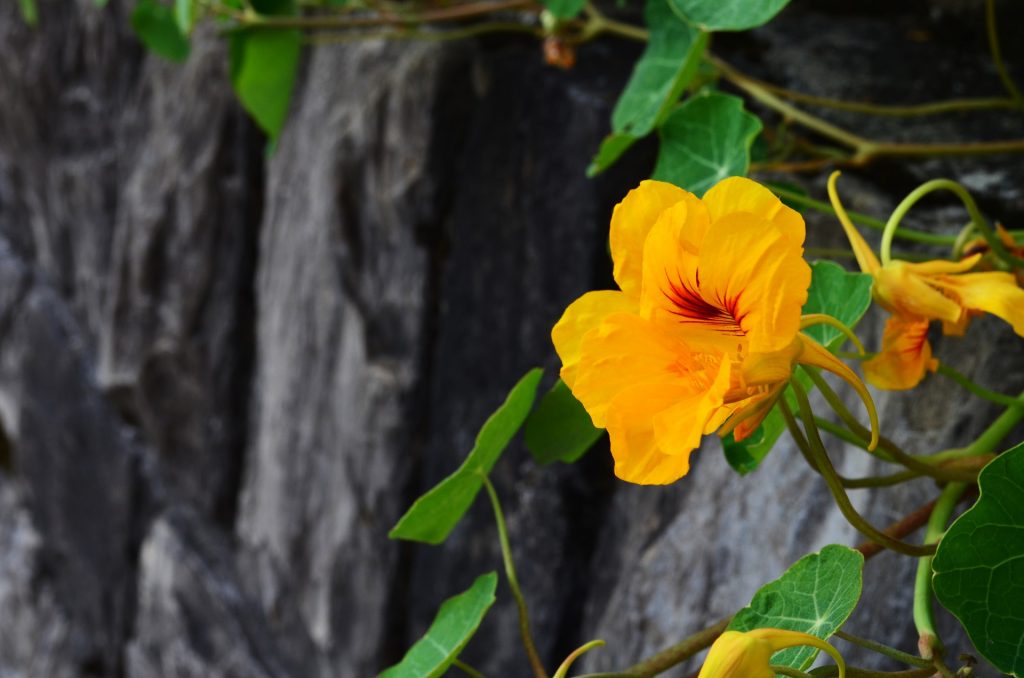
How to Grow and Use Nasturtium for Health
Even if you didn’t realize it, you’ve probably encountered nasturtium before. While some flowering plants in the garden offer a satisfying visual of color and geometry, nasturtium is as useful as it is beautiful.
Learning to recognize, cultivate, and use this plant can be of health benefit to both you and your garden. Let’s dig in.
How to Identify
With brightly-colored blooms of red, orange, and yellow, nasturtium is easy to spot as it blooms all summer in a wide variety of places. A trailing annual plant in most locales, people use it as ground cover, in hanging baskets, as a companion plant in vegetable gardens, in raised beds, and, sometimes, cascading downsloping lawns.
Nasturtiums are especially easy to identify by their distinct leaves. Round and buoyant, the silvery green and waxy leaves have a white dot in the middle with lined veins spreading out from the leaf’s center like a pie cut. Sound familiar? Look closely and you may be able to spot the cheerful blooms peeking out out the leaves with their warm colors.

Plant History
Native to South and Central America, nasturtiums are an incredibly popular plant. The genus’ scientific name is Tropaeolum. The name nasturtium comes from the Greek root “to twist”, implying “nose-twister” or “nose-tweaker” – an homage to the plant’s acrid smell and peppery taste.
The name and description of this plant first appear in written history in South America in 1704. The plant was brought to Europe in the 16th century where it took on a meaning of conquest and victory in battle. Even today, some people consider the plant to be a symbol of patriotism – a carry-over from the Victorian-era “language of flowers”.
One variety, “Gleam” was found in a convent in Mexico in the 1920s. It became particularly popular. Seeds sold for five cents each in the Great Depression.
Now, many people associate the plant with their grandmother’s garden and “old fashioned” aesthetics. Nasturtium’s popularity is again resurging as people look to incorporate these beloved, and classic, flowers to their own gardens. Some heirloom varieties date back to over one hundred years ago.
How to Grow
So are you ready to give it a try? Rest assured, you should be able to make it happen, no matter how lacking your green thumb might be.
Part of the plant’s popularity is attributed to just how easy it is to grow from seed. In fact, many beginning gardeners end up with way more nasturtium than they know what to do with. Nasturtium is not particular about soil quality and can do well in full sun or part shade.
To set yourself up for success, plant the nasturtium seeds in early spring in well-draining soil. If you are able to do this in an area that gets full sun, that is best.
There is really no need to fertilize the area as this plant prefers poor soil and can usually thrive without added help. Seed packets will have specific instructions for how deep and spread out to plant your seeds.
As your trusty correspondent, I can tell you from personal experience that you can also absentmindedly sprinkling the seeds in a garden bed, forget about them, and then find yourself completely overwhelmed by their proliferation around mid-July. Gardening can be intimidating but nasturtiums can be a great first step.

Health Benefits
Nasturtiums aren’t just easy to grow – they’re also edible and provide health benefits should you choose to munch on this garden snack.
Both the leaves and petals are loaded with nutritional value. Both contain high levels of vitamin C. They can help improve your immune system. Leaves and petals provide support if you experience a cold or sore throat. They contains healthy levels of magnesium, iron, and flavonoids.
A trained professional can use this plant to combat bacterial and fungal infections. Studies show that nasturtium leaves also have antibiotic properties – most effective prior to flowering.
Needless to say, nasturtium is practically an entire medicine cabinet in and of itself. In a time when a global pandemic shapes our individual lives and societal habits in unprecedented ways, preventative health practices, aided by the properties of beneficial plants, can be a way to take an active role in maintaining your own health. This is empowering – and nasturtium is the perfect ally.
Nasturtiums for Dinner
More than just medicine, nasturtium plants have been used in the kitchen for millennia. With their vibrant appearance and health benefits, it’s no wonder why that’s the case. Notably, people in Mexico and Peru have traditionally used nasturtiums to flavor dishes instead of watercress.
The entire plant is edible, so you don’t need to worry about separating parts in order to enjoy it. Popular recipes today include salad, pesto, and soup to name a few. A quick google search reveals that with enough imagination, this plant can be incorporated into almost any dish.
Companion Planting
In a delightful twist of continual awesomeness, nasturtiums don’t only feed humans and support our Homo sapien health. They are also great companion plants that keep other plants in the garden happy and healthy, too.
Nasturtiums can increase flavor in neighboring plants while also providing deterrence from pests. This is a great companion plant if you are trying to grow broccoli, cabbage, Brussel sprouts, cucumbers, radish, pumpkin, tomatoes, potatoes, and squash.
With a necessary emphasis on gardening sustainably and organically, nasturtium is a natural way to combat slugs, enrich your harvest, and add dimension and biodiversity to your garden.
—–
Like what you read? Subscribe to our newsletter for engaging articles, exclusive content, and the latest updates.
Check us out on EarthSnap, a free app brought to you by Eric Ralls and Earth.com.
—–














